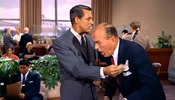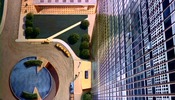United Nations, New York City, New York
The headquarters of the United Nations is a complex in New York City. The complex has served as the official headquarters of the United Nations since its completion in 1952 and is located in the Turtle Bay neighborhood of the borough of Manhattan, on spacious grounds overlooking the East River.
Hitchcock's Films
North by Northwest (1959)
After reading the final screenplay, United Nations officials refused to allow filming on or inside U.N. property. However, according to producer Herbert Coleman, an "important person in the U.N. security forces ... agreed to allow us to film the [required shots] under certain conditions." The conditions were that the film crew had to arrive exactly at 9am where they would find an access gate south of the main public entrance temporarily unlocked for 5 minutes, which would allow them just enough time to set up and film the key shots of Cary Grant pulling up in a taxi and walking towards the building, before being followed by one of the two assassins.[1]
On the day of filming, the camera crew were delayed in a traffic jam and arrived too late, finding the gates locked. Coleman and cameraman Robert Burks then attempted to shoot the footage using a camera concealed in a van which would park briefly at a dropping off point near the U.N. public entrance. With near military precision, the crew had planned the timing of the shot so that the taxis would pull in after Coleman signalled to them from outside the van. According to the producer's memoirs, just as they prepared to film the sequence, a security guard walked up and said, "Mr. Coleman, you've parked your camera van on United Nations property. Please move it immediately."[1]
The required footage was subsequently shot using a camera with a long focal-length lens hidden in a building on the opposite side of the road.[2] Coleman later recalled:
We shot the scene with Grant. Everything worked until he got almost to the entrance, when the gate guard realized who he was and began looking everywhere for our hidden cameras. He'd never seen the "assassins" and paid no attention to the one who'd entered the building.[3]
A further background plate of the street was shot which was used back on the studio sound stage for the medium shots of the men exiting the taxis. According to Coleman, this was achieved by using a hidden camera in a station wagon which parked up outside the entrance. The driver was dressed like a tourist and stepped out of the wagon to take photographs whilst the crew shot the footage. A security guard became suspicious and walked towards the wagon, but was intercepted by two crew members who pretended to be tourists and distracted the guard with questions about the various national flags. "By the time the guard had gone through all the nations, we had the footage we needed and drove away."[2]
To try and ensure the inside of the building could be reproduced in the studio, a stills photographer was hired to surreptitiously capture key shots of the inside of the UN building, so that they could be re-created later as studio sets and background transparencies.[4]
Matte paintings were used for the initial establishing shot of the UN lobby and also for the overhead shot of Roger Thornhill fleeing the building after the assassination.[5]
Google Maps
Nearest Locations
- Grand Central Station, New York City, New York (0.5 miles)
- Madison Avenue, New York City, New York (1.1 miles)
- Plaza Hotel, New York City, New York (1.1 miles)
- LaGuardia International Airport, New York City, New York (5.4 miles)
- Pulaski Skyway, New Jersey (6.7 miles)
Links
Notes & References
- ↑ 1.0 1.1 The Man Who Knew Hitchcock: A Hollywood Memoir (2007) by Herbert Coleman, page 282
- ↑ 2.0 2.1 The Man Who Knew Hitchcock: A Hollywood Memoir (2007) by Herbert Coleman, page 283
- ↑ At least one passer-by appears to do a double-take as they realise that Cary Grant has just walked by them.
- ↑ Alfred Hitchcock: A Life in Darkness and Light (2003) by Patrick McGilligan, page 569
- ↑ Two versions of this final matte are in existence — one appears in the DVD and Bluray releases of the film whilst a different one appears in the VHS home video releases.



